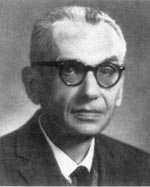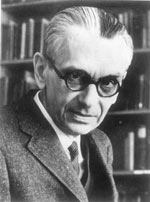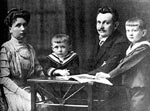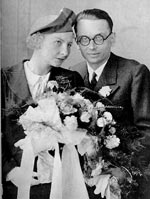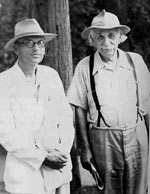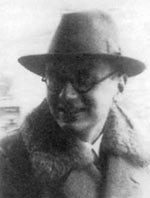
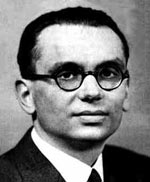
Born April 28 1906
Brno - Moravia Died 14th January 1978 Princeton New Jersey
(Starved himself to death)
In the early 1930's
Kurt Godel pulled the rug out from under the feet of philosophers, logicians
and mathematicians.
He
was regarded as a brilliant mathematician and perhaps the greatest logician
since Aristotle. And yet he died because he became convinced that the
doctors who were caring for him were intent upon poisoning him. Presumably
if he had had the slightest doubt about that, he would have taken the
risk, and eaten a morsel. Instead he made the choice to reject the food.
And starved himself to death.
Some further
biographical notes follow a brief discussion of some of Godel's ideas,
which have had important implications for mathematics and logic, as well
as for computer science.
This statement
is unprovable.
The following
sentence is true: This statement is unprovable.
Is it true? Well, suppose it were false. Then its opposite would be
true, and the statement would be provable. So, it must be true.
Is it unprovable? Yes. By its own account it is.
The truth of the statement is provable. But the statement itself is unprovable.
For Godel this was not merely a mind game. Using the mathematical representations of that reasoning, he showed, via what he called the incompleteness theorem, that it was not possible to prove the consistency of a formal system within the system itself.
The dream of a unitary system in which all mathematical truths could be deduced from a handful of axioms could not be realised. In this regard the hopes of Russell, Whitehead, Frege and a host of other logicians were dashed. Treasured ideas that had been accepted and in daily use for more than 2,000 years, since the time of Euclid, were profoundly challenged by this small, slight, quiet man, who with two papers managed to shake the structure of mathematics to its very foundation. Godel's ideas also have profound implications for computer science, as well as for As well as affecting mathematics, logic, philosophy, and truth itself.
During the 1920's shock waves had run through the science of physics, because of Heisenberg's Uncertainty Principle. But mathematics was believed to be on much firmer ground. In 1925 the most renowned mathematician of his day, David Hilbert, who was extremely good at giving pep talks, referred to certain wobbly moments that had been faced in the history of mathematics.
Such as:
- The paradoxes of the infenitisimals. Quantitities that are infinitely small but actually exist. As Bishop Berkeley said, '...They are neither finite quantities, nor quantities infinitely small, nor yet nothing. May we not call them ghosts of departed quantities?'
- Set theory.
Bertrand Russell referred to a set of all sets which do not contain
themselves. Can such a set exist? The point is, such a set neither
contains
itself nor does it not contain itself.
'What we have experienced twice,' Hilbert said, ' Cannot happen a third time, and will never happen again.' And then there was Godel. The first of two papers that made Godel's name was his 1929 doctoral thesis, "The Completeness of the First Order Functional Calculus.' It was rather reassuring, considering what followed, dealing as it did with the rules of logic which had been developed up to that time and which Godel regarded as still adequate for their intended purpose. The questions he asked, concerning axioms and truths, could be proved under all interpretations of the symbols. And although some qualms were expressed in the work, they concerned entities that might masquerade as numbers, but would be essentially different from them. Mathematicians hoped such things did not exist.
It was the 1931 paper which caused all the trouble. It was called 'On formally undecidable propositions of Principia Mathematica and related systems.'
Godel's belongings and documents are now on display at the Institute for Advance Study thanks to the tireless efforts of John W. Dawson, a mathematician from Penn State University. Dawson is also co-editor of Godel's Collected Works, which involved deciphering page after page of Godel's old German shorthand. Among the many effects gathered from 60 boxes of possessions, is a bookseller's statement, recording Godel's purchase, on the 31st July 1928, of Principia Mathematica, the three volume work by Russell and Whitehead. It is a most careful work, which in the English version takes 362 pages to prove that 1+1=2. Godel reduced the entire vast structure to rubble. What's more, he established that mathematics is not the omnipotentsystem that Hilbert had declared it to be. Hilbert had said, '...in mathematics there is no ignorabimus'. What he meant was: mathematicians do not say, 'We'll never know.'
Russell and Whitehead's Principia Mathematica was intended to be an all-encompassing document. Godel's comment in the paper was devastating. '..one might...conjecture that these axioms and rules of inference are sufficient to decide any mathematical question that can be formally expressed in these systems. It will be shown that this is not the case.' And so it was that Godel provided a proposition that, contrary to all expectations, could not be proven true in the sytem in which it was expressed.
'This statement is unprovable'. The
proposition is in fact unprovable. But because of that very fact
it is true. It is a true proposition that cannot be proven to be
true.
Godel had intended to become a physicist, but inspired by the lectures of Philipp Furtwangler and Hans Hahn, he switched to mathematics. Hahn in particular was swift to recognise Godel's potential and invited him to join the fabled Vienna Circle, where he came into contact with such philosophers as Schlick and Carnap and and encountered the ideas of Mach and Wittgenstein. Some members of the Vienna Circle also had an interest in paranormal phenomena.
Indeed Godel himself was convinced that in the future it would be considered a great oddity that twentieth century scientists had studied elementary particle physics but had failed even to consider the possibility of elementary psychic factors. Once Godel's great papers were published, he received an invitation to join the Institute for Advanced Study, a hothouse for genius.
Godel was also said to be attractive to women; the great love of his life, and the only person to get really close to him was Adele Porkert, sometimes called Adele Nimbursky - perhaps Pokert was her stage name. She was a dancer, and he'd met her in a Viennese nightspot. She became his wife, much to the distaste of his family. Adele Godel has been described as having had a 'disfiguring' birthmark on her face, the colour of port wine, but appears, in photographs at least, to have been a beauty. Their relationship lasted 45 years, and she was the only one who could persuade him to eat. He wasted away while she was in hospital. She died three years later, in 1981, and although snobbish Princeton was never particularly kind to her, she bequeathed Godel's papers to the Institute for Advanced Study; she believed in him and in his legacy.She had accompanied him to America and back to Germany during the 1930's, and then, when Godel was actually called up to serve as one of Hitler's soldiers, she accompanied him back to America again.
Godel did not have many close friends but the economist Oskar Morgenstern and the great physicist Albert Einstein spent time with him; indeed Godel and Einstein were often seen taking walks together. One of the stories that has been passed down about Godel's ever-active mind concerns a trip that Morgenstern, Einstein and he made by car - on the 21st April 1948. They drove to the government offices in Trenton, the capital of New Jersey, a rough town about a half an hour from Princeton. Einstein chatted all the way, in order to keep his friend distracted from the ordeal ahead. When it came to be his turn to be examined by a U.S. official, he made sure the form stated that he was Austrian, not German. That was perhaps a necessary correction but his friends were nervous about further outbursts. Then the functionary expressed sympathy about the terrible dictatorship which Godel had experienced first hand, and that he should therefore be permitted to remain in America, where such a repressive regime was impossible. Godel called out, 'On the contrary, I know how that can happen, quite legally. This constitution states - ' Before he could ruin all chances of gaining U.S. citizenship, Einstein and Morgenstern forcibly restrained him.
Godel's reputation among mathematicians, logicians and philosophers was considerable, and yet it took the Institute for Advanced Study 20 years before he was awarded a professorship there. He was a Platonist. He believed in numbers as 'objects. And, althougn Hilbert and other mathematicians were dismayed by Godel's incompleteness theorems, he himself did not believe that he had demonstrated the inadequacy of the so called axiomatic method. He simply felt that the demonstration of theorems was not a mechanical process, and that in mathematical research an important role was played by intuition.
Other discussions in which Godel engaged included his lectures at the Institute in 1938, when he addressed set theory again, addressing the inevitable fact that the set of all decimal numbers is larger than the set of all natural numbers and that no set has a size intermediate between those two.
He also addressed counterintuitive anomalies in what is called the axiom of choice: for instance a sphere may be decomposed into a finite number of pieces that can be separated and then reassembled, using only rigid systems, to form a new sphere which woul have twice the volume of the first.
By 1938 Godel had given up set theory and turned to philosophy and even relativity theory. In 1949 he showed that it was compatible with Einstein's equation to consider universes in which time travel was possible. Going further in his discussions with Einstein, he also came to the conclusion that both the lapse of time and the existence of change in nature were unreal and illusory. For his this was unequivocal proof of the views of Parmenides and Kant. Change, he said, is an 'appearance due to our special mode of perception'. He published his work on general relativity in a 1949 paper, in which he tells of a 'rotating universe', a cosmic pool of whirling matter. And that swirling material gives rise to space-time trajectories that loop back upon themselves. So, time is not made up of a linear sequence of events, but bends around the cosmos in a bending line. He wrote, 'By making a round trip on a rocket ship in a sufficiently wide curve, it is possible to travel into any region of the past, present, and future, and back again.'
The ideas put forward by Godel in his incompleteness paper are relevant to what is known as recursive function theory - the study of what can and cannot be done by an ideal computer. Firstly it has been discovered that computers are subject to an insoluble 'halting' problem. This involves the difficulty of deciding - for an arbitrary computer with an arbitrary input - whether that computer will at any time or eventuallt 'halt' and produce and output, rather thanremaion stuck in an unending. Another problem is rather topical since it includes the question of viruses: No programme that does not alter a computer's operating system can detect all programmes that do. Kurt godel's ideas and writings will be studied and pondered over for many years to come. A final question that he tackled and is yet to obtain a wider audience has to do his approach to St. Anselm's proof for the existence of God.
(St. Anselm's
proof begins with the idea that God is "that than which nothing greater
can be conceived". This can be reformulated : "the thought object than
which no thought object can be thought to be greater".
(1) God is
the thought object than which no thought object can be thought to be greater
Now suppose that
(2) God is only in the intellect (i.e. God is thought of, but does not
exist) But certainly
(3) any thought object that can be thought to exist in reality can be
thought to be greater than any thought object that is only in the intellect
And it cannot be doubted that
(4) God can
be thought to exist in reality Therefore,
(5) Some thought object can be thought to be greater than the thought
object than which no thought object can be thought to be greater which
is a contradiction, whence we have to abandon our supposition that God
is only in the intellect, so he has to exist in reality, too. Implied
from [1,2,3,4]) Godel's
ontological argument for the existence of God appears in his Collected
Works, which are steadily attracting more and more attention.
